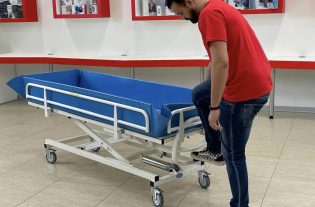I never give up on travelling, on getting out and about, whether it’s just a few kilometres’ distance or further afield. Usually, when I travel, I take the manual wheelchair with me, because it is easier to handle and overcome small architectural barriers, such as steps or to store away in the hold of a plane. The mistake to avoid when choosing your destination is not to think only about being able to get to attractions such as museums, churches, and so on… we need to worry about being able to enjoy that city, from the pavements, to public transport, to accommodation facilities. That’s why travelling in a wheelchair is not impossible, but it needs to be carefully planned before departure, scheduling all movements like clockwork. We don’t always rely on others, first of all because we don’t have the mathematical certainty of receiving their help, and secondly because we don’t all enjoy being helped. And we forget that we won’t find the same comforts we have at home; we need to forgo some things, we need to cream off the unnecessary excess.
?Let’s begin by understanding which is the most suitable way to reach our destination. Both trains and air planes are suitable means of transport to carry people with disabilities, thanks to the dedicated services they offer. However, these services need to be requested correctly, observing specific time frames and providing all the necessary documentation to avoid literally being left standing.
Travelling by train is usually the simplest form of travel. You book your ticket online if you are travelling alone, or you can add a carer who can travel with you at a reduced rate or even free of charge, to reserve the special seat for disabled travellers. How do you get onto the train? Trenitalia offers a service called “Sala Blu” (Blue Room) which is free of charge. You need to book it at least 48 hours in advance, just to be on the safe side, by e-mail or visiting the departure station. The service entails meeting up at the station half an hour before your departure time, and the dedicated staff takes you and accompanies you to the platform, then lifts you and your wheelchair up on a special lift and takes you directly to your reserved seat. The service is the same even if you have a carer travelling with you. At the arrival station, a member of staff will help you off the train in the same way and will accompany you outside the station.
When I travel by plane, the same thing applies; when I book my flight, I extend my reservation to the airport service to accompany me and my wheelchair directly onto my seat on the plane. Be extra careful because requesting these special services are marked by specific acronyms or symbols, so take care to pick the most suitable service for your particular situation. Since I travel in a wheelchair and cannot walk, I always pick the option “WCHC”: passengers who are completely immobile and require a wheelchair to/from the aircraft and must be carried up/down the steps and to/from their cabin seat.
To avoid a panic, the web is an excellent source of information from other wheelchair-bound travellers who have already been to your chosen destination, and there are also associations or tourist portals who can support you in planning and managing a fully accessible trip: “Diversamente Africa”, “Tutti turisti in Thailandia”, “No barrier”, “Strabordo”, “Viaggiare diverso” are just some of the concerns set up in recent years to organise trips tailor-made for people with disabilities.
Personally, I organise my trips autonomously and I will be going to Lisbon in a few months’ time with a group of friends: every year, we visit a European city together. After Spain, with Madrid and Valencia, this time we are going to Portugal. I love travelling for myself and also to tell others, who are in my condition as well as those who aren’t, that getting around is a right, foregoing which is a little like dying.










